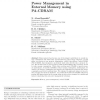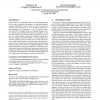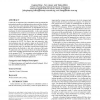119 search results - page 15 / 24 » Static Energy Reduction Techniques for Microprocessor Caches |
ISLPED
2006
ACM
14 years 1 months ago
2006
ACM
Today’s superscalar microprocessors use large, heavily-ported physical register files (RFs) to increase the instruction throughput. The high complexity and power dissipation of ...
IJES
2007
13 years 7 months ago
2007
Abstract: Main memory has become one of the largest contributors to overall energy consumption and offers many opportunities for power/energy reduction. In this paper, we propose ...
CODES
2008
IEEE
14 years 2 months ago
2008
IEEE
Processor Idle Cycle Aggregation (PICA) is a promising approach for low power execution of processors, in which small memory stalls are aggregated to create a large one, and the p...
ICS
1998
Tsinghua U.
13 years 11 months ago
1998
Tsinghua U.
In order to achieve high performance, contemporary microprocessors must effectively process the four major instruction types: ALU, branch, load, and store instructions. This paper...
DAC
2012
ACM
11 years 10 months ago
2012
ACM
Caches play an important role in embedded systems by bridging the performance gap between high speed processors and slow memory. At the same time, caches introduce imprecision in ...



